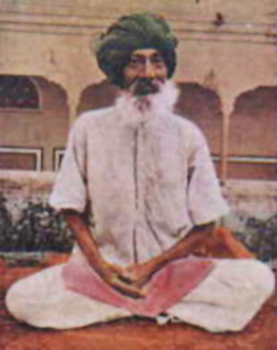 Thakur Ram Singhji established the ideals of Sufi conduct and devotion by setting his own life as an example. He was born on 3rd September 1898 in the village Manoharpura in a Raulot Bhati family of Rajputs. His father, Thakur Mangal Singhji, was a religious and devoted person. He served the Jaipur state in the capacity of the `Guardian of the Fort` (Kiledar). Thakur Ram Singhji`s mother also was a very religious and pious lady. The religious bent of the mind of parents had its influence on the son, Thakur Ram Singhji. He was deeply interested in religion right from childhood.
Thakur Ram Singhji established the ideals of Sufi conduct and devotion by setting his own life as an example. He was born on 3rd September 1898 in the village Manoharpura in a Raulot Bhati family of Rajputs. His father, Thakur Mangal Singhji, was a religious and devoted person. He served the Jaipur state in the capacity of the `Guardian of the Fort` (Kiledar). Thakur Ram Singhji`s mother also was a very religious and pious lady. The religious bent of the mind of parents had its influence on the son, Thakur Ram Singhji. He was deeply interested in religion right from childhood.
Thakur Ram Singhji was admitted to the Nobles School in Jaipur, where he learnt the Urdu language, Persian and English besides Hindi. Later he was employed in the Police Department of Jaipur State. He joined as a constable and through his honesty, sincerity and hard work rose to the post of `Thanedar` (Station In charge or Sub-Inspector of Police) before retiring from the police service in the year 1944 at the age of 46 years to devote himself completely for the mission of his Master.
Thakur Ram Singhji had a heart full of compassion. He took a lot of interest in growing trees and in feeding birds. He turned his village green. Even in the compounds of Police Station where he was posted, he grew lots of trees and looked after them. If anyone damaged trees, he used to feel pained. Feeding birds was his daily routine. In Sawai Madhopur, birds even used to pick up raisins from his hands. A part of his income was regularly given for the use of poor and this was done so secretly that no one would know of this.
When Thakur Ram Singhji was posted in Palsar, a certain Shri Kishan Chandra Bhargava gave him a photograph of Mahatma Ram Chandraji. Hwen he began meditating on that photograph he started receiving spiritual radiations. He wrote a letter to Mahatma Ram Chandraji expressing his inability to personally visit him. Mahatma Ram Chandraji quickly wrote back to him saying that he himself was coming to Jaipur and would meet him then. A few days later Mahatma Ram Chandraji arrived and when he saw Thakur Ram Singh, he remarked, that Ram Singh looked exactly like he had visualised him, even though they had never met before. In the first meeting itself Thakur Ram Singhji was deeply struck by the master and said that he had become one with him. When he was returning back, Mahatma Ram Chandraji blessed him to become a `Fanafil-Murid` i.e. a disciple with whom his Master has merged and said that his fame would spread like the smell of roses.
His devotion and his merger with his Master were such that he often forgot his own existence. At times he could not even recall his name. The saintly behaviour of Thakur Ram Singh left an unforgettable impression on every one who came in his contact. Many officers from the Police Department were deeply impressed by him, some of whom changed their way of living. Thakur Ram Singhji had become a living legend in the Police Department. His reputation as an honest and sincere officer with absolute integrity had reached far and wide in the entire Jaipur State. Even the Courts were not left untouched from it. The Nazim Ikram Hussain of Shaikhawati was also impressed by him to such an extent that if Thakur Ram Singhji presented any inquiry report before him, he would deliver his judgment based on that report without any further investigation. He would not even call many witnesses.
Thus Thakur Ram Sighji attracted a number of followers in his lifetime not by any outward display but by leading a simple lifestyle and finding God in that simplicity.



















